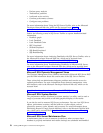v Leave the Autogrow feature on for the data files and the log files. This helps
the SQL Server to automatically increase allocated resources when necessary.
v Set a reasonable size for the Autogrow increment. Setting the database to
automatically grow results in some performance degradation. Therefore you
should set a reasonable size for the Autogrow increment to prevent the database
from growing automatically often.
v Set the maximum size for the data files and log files in order to prevent the
disk drives from running out of space.
v If you have several physical disk arrays, try to create at least as many files as
there are physical disk arrays so that you have one file per disk array. This
improves performance because when a table is accessed sequentially, a separate
thread is created for each file on each disk array in order to read the table's data
in parallel.
v Place the heavily accessed tables in one file group and place the tables' indexes
in a different file group on a different physical disk arrays. This improves
performance, because separate threads will be created to access the tables and
indexes. For more information about Sterling B2B Integrator tables, refer to the
"Schema Objects" and "Sterling B2B Integrator Database Tables" sections in the
topic “Database management for Sterling B2B Integrator” on page 16.
I/O Sub-System Response Time
Sterling B2B Integrator is an On-Line Transaction Processing (OLTP) application.
As an OLTP application, database response time to the I/O sub-system needs to be
in the single digit range even during the peak periods. The database response time
to the I/O sub-system should be less than:
v 5 ms for logs. 1ms or better is recommended.
v 10 ms or better for data. 5ms is recommended.
Monitoring Microsoft SQL Server Using Microsoft SQL Server
Management Studio
Microsoft SQL Server Management Studio is a tool kit for configuring, managing,
and administering all components of Microsoft SQL Server.
Microsoft SQL Server Management Studio combines the features of Enterprise
Manager, Query Analyzer, and Analysis Manager.
For more information about Microsoft SQL Server Management Studio, refer to the
Microsoft Developer Network Web site, which can be accessed from:
http://msdn.microsoft.com/en-us/library/ms174173(SQL.90).aspx.
Monitoring Microsoft SQL Server Using SQL Server Profiler
SQL Server Profiler is a graphical tool used to monitor an instance of Microsoft
SQL Server.
This tool is a good troubleshooting tool, but should not be enabled for day-to-day
operations because there is an inherent overhead in capturing this data daily. The
data about each event can be captured to a file or a table for analysis at a later
date.
The SQL Server Profiler can be used to:
v Monitor the performance of an instance of the SQL Server Database Engine
v Identify procedures and queries that are executing slowly
v Replay traces of one or more users
Performance Management 57


















